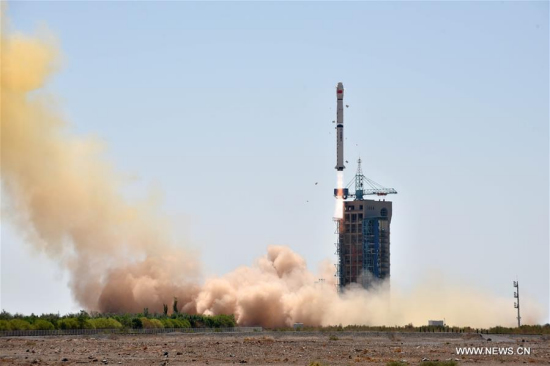
A Long March-4B rocket carrying X-ray space telescope to observe black holes, pulsars and gamma-ray bursts blasts off from Jiuquan Satellite Launch Center in northwest China's Gobi Desert, June 15, 2017. (Xinhua/Zhen Zhe)
China launched its first X-ray space telescope to observe black holes, pulsars and gamma-ray bursts, via a Long March-4B rocket from Jiuquan Satellite Launch Center in northwest China's Gobi Desert at 11 a.m. Thursday.
The 2.5-ton Hard X-ray Modulation Telescope (HXMT), dubbed Insight, was sent into an orbit of 550 kilometers above the earth to help scientists better understand the evolution of black holes, and the strong magnetic fields and the interiors of pulsars.
Through the telescope, scientists will also study how to use pulsars for spacecraft navigation, and search for gamma-ray bursts corresponding to gravitational waves.
The result of the wisdom and efforts of several generations of Chinese scientists, Insight is expected to push forward the development of space astronomy and improve space X-ray detection technology in China.
Insight can be regarded as a small observatory in space, as it carries a trio of detectors -- the high energy X-ray telescope (HE), the medium energy X-ray telescope (ME) and the low energy X-ray telescope (LE) -- that cover a broad energy band from 1 keV to 250 keV, said Lu Fangjun, chief designer of the payload.
Based on the demodulation technique first proposed by Li Tipei, an academician of the Chinese Academy of Sciences (CAS), in 1993, the HE has a total detection area of more than 5,000 square centimeters, the world's largest in its energy band.
"Given it has a larger detection area than other X-ray probes, HXMT can identify more features of known sources," said Xiong Shaolin, a scientist at the Institute of High Energy Physics of the CAS.
Chen Yong, chief designer of the LE, said X-rays of lower energy usually have more photons, so a telescope based on a focusing technique is not suitable for observing very bright objects emitting soft X-rays, as too many photons at a time will result in over-exposure.
But HXMT won't have that problem, as its collimators diffuse photons instead of focusing them. "No matter how bright the sources are, our telescope won't be blinded," said Chen.
According to Zhang Shuangnan, HXMT lead scientist, the satellite's developers found that a set of HXMT high-energy detectors, originally designed to shield background noises caused by unwanted X-ray photons, especially those from behind the telescope, could be adjusted to observe gamma-ray bursts.
The creative new function pushes the satellite's observation band up to 3 MeV and will get a very good energy spectrum, Zhang said.
"We are looking forward to discovering new activities of black holes and studying the state of neutron stars under extreme gravity and density conditions, and physical laws under extreme magnetic fields. These studies are expected to bring new breakthroughs in physics."
Compared with X-ray astronomical satellites of other countries, HXMT has a larger detection area, broader energy range and wider field of view. These give it advantages in observing black holes and neutron stars emitting bright X-rays, and it can more efficiently scan the galaxy, Zhang said.
Other satellites have conducted sky surveys and found many celestial sources of X-rays. However, the sources are often variable, and occasional intense flares can be missed in just one or two surveys, according to him.
New surveys can discover either new X-ray sources or new activities in known sources. So HXMT will repeatedly scan the Milky Way for active and variable celestial bodies emitting X-rays.
"There are so many black holes and neutron stars in the universe, but we don't have a thorough understanding of any of them. So we need new satellites to observe more," Zhang said.
"Black holes will be the focus of our observation since they are very interesting, and can generate various types of radiation, including X-rays and high energy cosmic rays, as well as strong jets."
So far about 20 black holes have been found in our galaxy. "We hope our telescope can discover more black holes. We also hope to better observe the black holes already discovered."
Sometimes a black hole is calm, but other times it's very "bad tempered." When a black hole gets "angry," it generates very strong X-rays or gamma ray bursts or jet-flows, Zhang explained.
Other countries have sent several X-ray satellites into orbit, but most are suitable for observing only relatively calm black holes. However, HXMT is suitable for observing angry black holes and neutron stars.
"We are still not clear why some black holes suddenly get angry, since we haven't observed them for long enough," said Zhang. "We plan to make a thorough survey of black holes and neutron stars in the galaxy."
A neutron star, or a pulsar, is so strange that when the first one was discovered, it was mistaken for signals from aliens. There are still many mysteries about this kind of star.
"We are still not clear about the interiors of pulsars. Current physical laws cannot describe the substances in the state of a pulsar well, since no lab on Earth can create a density as high as a pulsar. So we have to conduct more observations of pulsars."
Since the detection of gravitational waves, scientists have been eager to find electromagnetic signals corresponding to the gravitational waves. This will be an important task for Insight.
Some scientists suspect that mysterious gamma-ray bursts could be electromagnetic signals corresponding to gravitational waves.
HXMT's effective detection area for monitoring gamma-ray bursts is 10 times that of the US Fermi space telescope. Scientists estimate that HXMT could detect almost 200 gamma-ray burst events a year.
"HXMT can play a vital role in searching for electromagnetic signals corresponding to gravitational waves," said Zhang. "If HXMT can detect electromagnetic signals corresponding to gravitational waves, it would be its most wonderful scientific finding."


















































